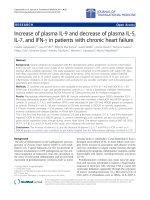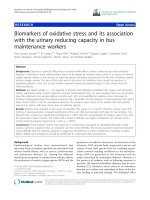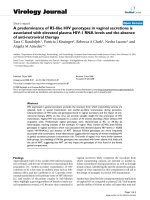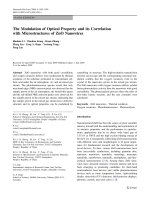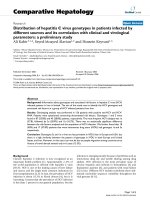Investigation of plasma amyloid beta 1-42 levels and its correlation with some cardiovascular risk factors in people over forty years old
Bạn đang xem bản rút gọn của tài liệu. Xem và tải ngay bản đầy đủ của tài liệu tại đây (154.82 KB, 6 trang )
Journal of military pharmaco-medicine No7-2016
INVESTIGATION OF PLASMA AMYLOID BETA 1-42 LEVELS
AND ITS CORRELATION WITH SOME CARDIOVASCULAR
RISK FACTORS IN PEOPLE OVER FORTY YEARS OLD
Nguyen Minh Hai*; Nguyen Minh Nui*; Ho Anh Son**
SUMMARY
Objectives: Amyloid beta 1-42 (Aβ 1-42) is related to several disorders including nervous,
cardiovascular and metabolic disorder. We investigated plasma Aβ 1-42 level and examined its
correlation with some cardiovascular risk factors. Subjects and methods: Level of Aβ 1-42 was
measured in plasma of 40 people over forty years old without type 2 diabetes mellitus and
hypertension by ELISA method. Results and conclusions: Average plasma Aβ 1-42 level was
98.88 ± 92.45 pg/mL, median was 65.49 pg/mL with wide range from 45.83 to 494.32 pg/mL.
There was no significant correlation between plasma Aβ 1-42 level and cardiovascular risk
factors such as age, plasma lipids.
* Key words: Metabolic disorder; Amyloid beta.
INTRODUCTION
Amyloid is a specific peptide family
including aggregating beta chains. Small,
focal, clinically silent amyloid deposits in
the brain, heart, seminal vesicles, and joints
is a universal accompaniment of aging.
These results in amyloidosis, structural
disorders, reduction and loss in function of
various organs in the body. The underlying
molecular abnormalities may be either
acquired or hereditary and about 20 different
proteins can form clinically or pathologically
significant amyloid fibrils in vivo. Brain
amyloid deposit is a major pathological
feature of Alzheimer disease. Islet amyloid
deposits trigger type 2 diabetes mellitus.
Amyloid also deposits in joints, peripheral
arteries, kidneys. Aβ 1-42 is one of amyloid
molecular, which is considered to relate
with different diseases such as Alzheimer’s
disease, diabetes, cardiovascular diseases
[2]. Although many studies about Aβ 1-42
have been performed, its role and physical
function is still unknown. So far in Vietnam,
there has been no investigation about the
exact physical function of Aβ 1-42.
Therefore, we carry out this study to:
- Examine the level of Aβ 1-42 plasma
in the people over 40 years old.
- Investigate whether there is any
relationship between plasma Aβ 1-42 level
and cardiovascular risk factors.
SUBJECTS AND METHODS
1. Subjects.
* Selection criteria:
Study was carried out on 40 people
over forty years old without type 2 diabetes
mellitus and hypertension.
* 103 Hospital
** Military Medical University
Corresponding author: Nguyen Minh Nui ()
35
Journal of military pharmaco-medicine No7-2016
2. Methods.
- Cross-sectional study without control
group.
- All people were clinically and paraclinically
examined by measuring weight, height,
blood pressure, level of glucose, creatinine,
acid uric, lipid in their blood. Level of
Aβ 1-42 plasma was measured by ELISA
method in Physiopathology Department,
Vietnam Millitary Medical University.
- Methods of Aβ 1-42 measurement [9]:
+ 5 mL of whole bood was taken into
tubes with anticoagulant (citrate) in the
morning. Afterward, the sample was
centrifugated for 20 min at 2,000 rpm.
Collect the supernatant carefully as plasma
sample. If precipitate was seen during
reservation, the sample should be centrifugated
again.
+ The Microelisa stripplate provided in
the ELISA kit has been pre-coated with an
antibody specific to Aβ 1-42. Standards or
samples were added to the appropriate
Microelisa stripplate wells and combined
to the specific antibody. Then a Horseradish
Peroxidase (HRP) - conjugated antibody
specific for Aβ 1-42 was added to each
Microelisa stripplate well and incubated.
Free components were washed away before
adding the Chromogen solution A and
Chromogen solution B to each well. Blue
only appreared in those wells that contain
Aβ 1-42 and Horseradish peroxidase
conjugated Aβ 1-42 antibody and then it
turned yellow after addition of the stop
solution. The optical density is measured
spectrophotometrically at a wavelength
of 450 nm. The optical density value is
36
proportional to the concentration of Aβ
1-42. The concentration of Aβ 1-42 in the
samples is calculated by comparing the
optical density of the samples to the
standard curve.
* Statistical analysis: to initially explore
the relationship between variable sets,
scattergram blots using Microsoft Excell
(2010), where a relationship was found.
Stata verson 12.0 was used to verify the
statistical significances of the association.
Simple linear regression was initially used.
Pearson chi-square was used to determine
the association between concentration
of Aβ 1-42 plasma and baseline participant
characteristics.
RESULTS
1. Characteristics of the subjects.
40 people included 24 males (60%) and
16 females (40%). Mean age was 54.38 ±
11.23 years.
2. Plasma Aβ 1-42 levels.
Table 1: Plasma Aβ 1-42 level.
Variable
Male (n = 24)
Level of Aβ 1-42 plasma
(pg/ml)
Mean ± SD
Median
(Min - max)
83.77 ± 58.17
64.46
(45.83 - 313.64)
Female (n = 16) 121.55 ± 126.97
66.67
(47.59 - 494.32)
Summarization
65.49
(45.83 - 494.32)
98.88 ± 92.45
Both mean and medium plasma Aβ 1-42
in male were not significantly lower than
those in female (p > 0.05). Levels of Aβ 1-42
fluctuated from 45.83 pg/mL to 494.32 pg/mL.
Journal of military pharmaco-medicine No7-2016
3. Association between plasma Aβ 1-42 levels with age, blood glucose and
acid uric levels.
Aβ 1-42 (pg/mL)
* Association between plasma Aβ 1-42 levels and age:
Figure 1: Correlation between plasma Aβ 1-42 levels and age.
No significant correlation between plasma Aβ 1-42 levels and age of participants was
found (p > 0.05).
A = 5.6765 * Glucose + 71.579
r = 0.043, p= 0.79
600
600
500
500
A = -0.311 * Uric + 209.48
r = 0.251, p = 0.11
Aβ 1-42 (pg/mL)
Aβ 1-42 (pg/mL)
* Association of plasma Aβ 1-42 level with blood glucose and acid uric levels:
400
300
200
100
400
300
200
100
0
0
2
4
6
Glucose (mmol/L)
A
8
0
200
400
Acid uric (µmol/L)
600
B
Figure 2: Correlation between plasma Aβ 1-42 levels and glucose (A),
acid uric (B) levels.
Plasma Aβ 1-42 levels did not correlate with either glucose or acid uric levels
(p > 0.05).
37
Journal of military pharmaco-medicine No7-2016
4. Association between plasma Aβ 1-42 levels with total cholesterol, HDL-C,
LDL-C, and triglyceride levels.
600
A = -7.332 * Triglyceride +114.19
r = -0.138, p = 0.43
600
500
500
Aβ 1-42 (pg/mL)
Aβ 1-42 (pg/mL)
A = -20.324 * Cholesterol + 208.69
r = -0.022, p = 0.61
400
300
200
100
0
400
300
200
100
0
0
2
4
6
8
0
5
Triglyceride (mmol/L)
Cholesterol (mmol/L)
A
B
A= 111.17 * HDL - 40.721
r = 0.327, p = 0.08
A = -37.177 * LDL + 222.65
r =-0.34, p = 0.44
600
600
500
500
Aβ 1-42 (pg/mL)
Aβ 1-42 (pg/mL)
10
400
300
200
100
400
300
200
100
0
0
0
0.5
1
1.5
2
HDL-C (mmol/L)
C
0
2
4
6
LDL-C (mmol/L)
D
Figure 1: Correlation between plasma Aβ 1-42 levels, cholesterol (A), triglyceride (B),
HDL-C (C) and LDL-C (D).
No significant correlation of plasma Aβ 1-42 plasma levels with cholesterol, triglyceride,
HDL-C and LDL-C was observed.
DISCUSSION
Aβ 1-42 is supposed to relate to a variety
of disorders such as Alzheimer’s disease,
type 2 diabetes mellitus. In the body, Aβ 1-42
38
can be solute in cerebrospinal fluid and
blood or deposits in brain, pancreas.
We investigated whether there were any
associations between plasma Aβ 1-42
levels and cardiovascular risk factors.
Journal of military pharmaco-medicine No7-2016
In our study, the mean (±SD) and median
plasma Aβ 1-42 were 98.88 ± 92.45 (pg/mL)
and 65.49 (pg/mL). The concentration of
Aβ 1-42 plasma fluctuated in a large range
between 45.83 (pg/mL) and approximately
500 (pg/mL). It was interesting to note that
participants who had the highest plasma
Aβ 1-42 level had normal levels of lipid,
glucose, acid uric in the blood with total
cholesterol = 5.17 (mmol/L), HDL-C = 1.8
mmol/L, LDL-C = 3 (mmol/L), LDL-C = 3
(mmol/L), triglyceride = 0.54 (mmol/L), acid
uric = 327 (µmol/L).
Metti and his colleagues (2012) used
Innogenetics INNO-BIA assays to measure
plasma Aβ 1-42 level in 988 communitydwelling elders who suffer from diabetes,
stroke, myocardial infarction and hypertension.
Mean age of these patients was 74.0 ±
3 years. The mean (±SD) and median of
plasma Aβ 1-42 levels were 33.9 ± 9.7 and
32.83 (pg/mL) [7]. The mean and plasma
Aβ 1-42 levels in our study were both similar
to Mehta and Metti’s findings. Thus, the
differences in plasma Aβ 1-42 levels in
these studies were affected significantly
by age.
In the study by Kelvin et al, mean (±SD)
and medium of plasma Aβ 1-42 levels in
a group of 18 healthy adults were 29.1 ±
18.1 (pg/mL) and 27 (pg/mL). These results
were lower than our findings and the
concentration of plasma Aβ 1-42 levels
fluctuated in narrower range between 2.5
(pg/mL) and 62 (pg/mL). However, mean
age of the participants in Kelvin’s research
was 36, which was lower than the figure
in our study [4].
High plasma cholesterol, triglyceride
and LDL levels, as well as low plasma
HDL levels have long been known to be
associated with cardiovascular risk factors
and have been identified as significant
risk factors for Alzheimer’s disease. HDL
has been shown to carry Aβ 1-42 in plasma
and cerebrospinal fluid [1]. Plasma HDL
has been reported to be lower in patients
with Alzheimer’s disease and is highly
correlated with lower cognitive scores
from these patients [1, 3]. Many studies
indicated that HDL which interact with
Aβ 1-42 in plasma, can regulate Aβ 1-42
aggregation, degradation and toxicity
[5, 8]. Our study did not show significant
associations between levels of total
cholesterol, triglyceride, LDL-C or HDL-C
and Aβ 1-42 levels. This results were
similar to those of Kelvin et al in 2005 [4].
In 2000, Mehta and his colleagues
conducted a study on the patients older
than forty with Alzheimer’s disease and
control subjects. Levels of Aβ 1-42 plasma
were measured by a sandwich enzymelinked immunosorbent assay. Both the
medium of plasma Aβ 1-42 levels in group
of Alzheimer’s disease and control group
were higher than the results of our study
with 73 (pg/mL) (minimum = 25 pg/mL,
maximum = 880 pg/mL) and 81 (pg/mL)
(minimum = 25 pg/mL, maximum = 905
pg/mL), respectively. The plasma Aβ 1-42
levels also fluctuated in a large range [6].
However, our study was performed in
healthy individuals. Whether there is any
correlation between Aβ 1-42 levels and
cardiovascular risk factors in diabetic patients
as well as in healthy people, which need
to be investigated in the future.
39
Journal of military pharmaco-medicine No7-2016
CONCLUSION
The mean and medium of plasma Aβ 1-42
levels in people over forty years old were
98.88 ± 92.45 (pg/mL) and 65.49 (pg/mL)
and plasma Aβ 1-42 levels fluctuated in a
large range between 45.83 (pg/mL) and
494.32 (pg/mL). No correlations between
Aβ 1-42 levels and several cardiovascular
risk factors such age, plasma glucose,
acid uric and lipids levels were observed.
REFERENCES
1. Cole G. M, Beech W, Frautschy S. A et al.
Lipoprotein effects on Abeta accumulation and
degradation by microglia in vitro. J Neurosci Res.
1999, 57 (4), pp. 504-520.
2. David A. Warrell, Timothy M. Cox, Firth.
JD. Oxford Textbook of Medicine. 4th Edition ed.:
Oxford University Press. 2003, pp.163-167.
3. Farhangrazi ZS, Ying H, Bu G et al. High
density lipoprotein decreases beta-amyloid
toxicity in cortical cell culture. Neuroreport.
1997, 8 (5), pp.1127-1130.
4. Kelvin Balakrishnana, Giuseppe Verdilea,
Pankaj D. Mehtad et al. Plasma Aβ42 correlates
40
positively with increased body fat in healthy
individuals. Journal of Alzheimer’s Disease.
2005, 8, pp.269-282.
5. Kuo YM, Emmerling MR, Bisgaier CL et al.
Elevated low-density lipoprotein in Alzheimer's
disease correlates with brain abeta 1-42 levels.
Biochem Biophys Res Commun. 1998, 252 (3),
pp.711-715.
6. Mehta PD, Pirttila T, Mehta SP et al.
Plasma and cerebrospinal fluid levels of
amyloid beta proteins 1-40 and 1-42 in
Alzheimer disease. Arch Neurol. 2000, 57 (1),
pp. 5-100.
7. Metti AL, Cauley JA, Newman AB et al.
Plasma beta amyloid level and depression in
older adults. J Gerontol A Biol Sci Med Sci.
2013, 68 (1), pp.74-79.
8. Olesen OF, Dago L. High density
lipoprotein inhibits assembly of amyloid betapeptides into fibrils. Biochem Biophys Res
Commun. 2000, 270 (1), pp.62-66.
9. Schmidt S, Matthew J, Nixon R, Mathews
measurement
by
enzyme-linked
P.
Aβ
immunosorbent assay in Sigurdsson, E.M.,
Calero, M. & Gasset, M. (eds.) Amyloid
Proteins Methods in Molecular Biology:
Humana Press. 2012, pp.507-527.

